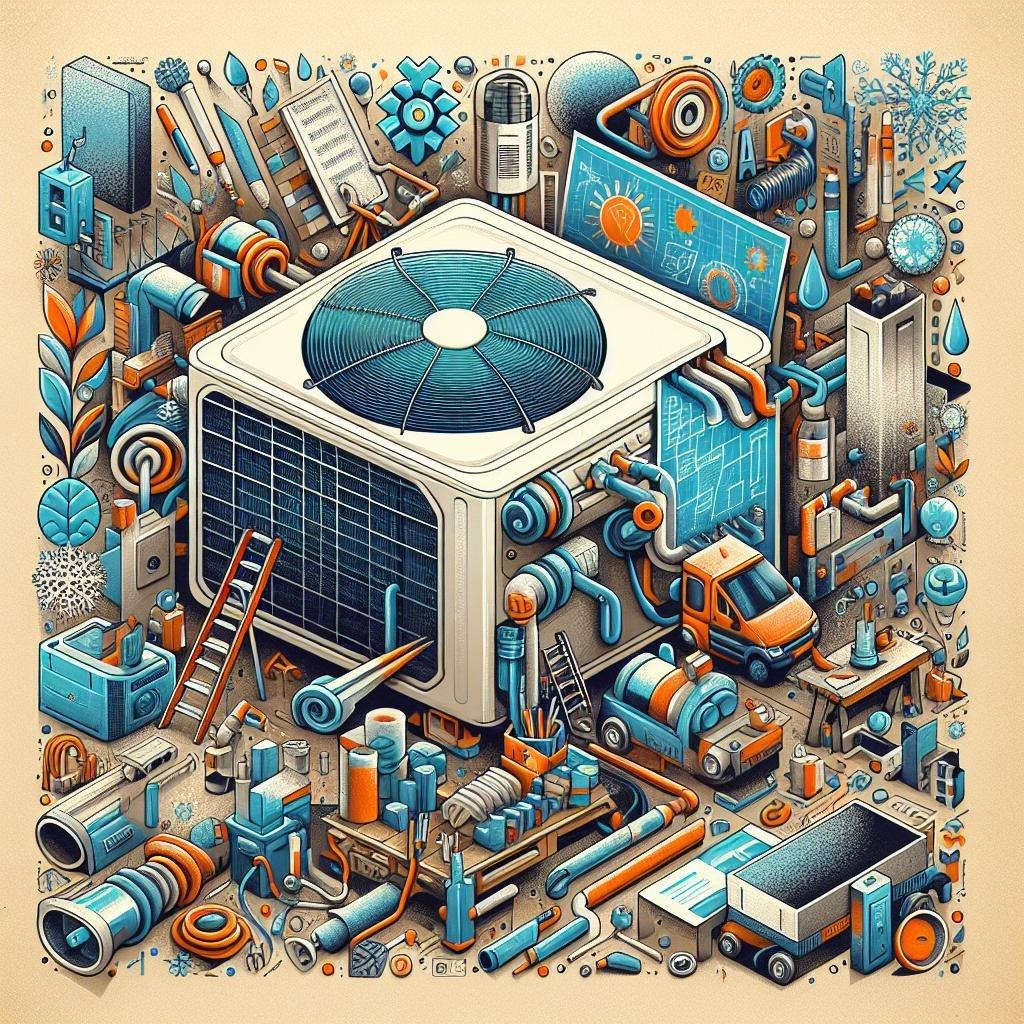In the quest for optimal climate control,mini split air conditioning systems have emerged as a popular choice for commercial spaces,offering energy efficiency and adaptability.Though, as with any system, the path to achieving the ideal indoor environment is fraught with potential pitfalls. From improper sizing and placement to overlooked maintenance considerations,common mistakes and oversights in the design and installation of mini split AC units can lead to significant setbacks and increased operational costs. In this article, we will explore these frequent missteps, shedding light on the intricacies of mini split systems and providing insights to help business owners and facility managers navigate the complexities of effective air conditioning solutions. Whether you’re embarking on a new installation or considering an upgrade, understanding these common errors is the first step toward creating a comfortable and efficient commercial space.
Understanding Load Calculation and Its Impact on Mini Split Efficiency
Proper load calculation is essential in determining the thermal requirements of a commercial space,influencing not just the comfort levels but also the efficiency of mini split systems. A common misconception is that a one-size-fits-all approach can be used; however, each space has unique properties that affect heat gain and loss. factors to consider include:
- Insulation quality: Well-insulated spaces retain cool air better.
- Window types and placements: High sun exposure can dramatically increase cooling demand.
- Occupancy levels: More people generate more heat, impacting overall load calculations.
Inaccurate calculations can lead to several issues, including over-sizing or under-sizing the system. An oversized unit can cycle on and off too frequently, leading to increased energy consumption and short-circuiting its dehumidification capability.On the other hand, an under-sized system struggles to maintain set temperatures, increasing wear and tear. These outcomes can significantly impact the total cost of ownership, which can be summarized in the following table:
| System Size | Impact | Energy Efficiency |
|---|---|---|
| Oversized | Frequent cycling | Lower due to short-cycling |
| Undersized | Inadequate cooling | Higher due to prolonged operation |
Common Installation Errors That Compromise Airflow and Performance
During the installation of mini split air conditioning systems,a multitude of errors can inadvertently compromise airflow and performance. One of the most frequent mistakes is improper positioning of the indoor and outdoor units. If the indoor unit is too far from the outdoor condenser, it can lead to insufficient refrigerant flow, causing the system to work harder, which ultimately reduces efficiency. Additionally, failing to adequately insulate the refrigerant lines can contribute to heat gain, especially in commercial applications with significant temperature variation. Other common oversights include neglecting the need for proper drainage, which can lead to water pooling and potential damage to the unit and surrounding areas.
Furthermore, inadequate sizing of the system is a critical factor that can severely impact performance. Oversized units frequently enough cycle on and off too frequently, leading to ineffective dehumidification and discomfort in the space. Conversely, undersized units may struggle to maintain comfortable temperatures, resulting in continuous operation and increased energy costs.It is indeed also essential to ensure that all air filters are clean and the return ducts are unobstructed. A simple oversight in these areas can restrict airflow, reduce overall system effectiveness, and propel energy bills unnecessarily high.

Neglecting Proper Drainage solutions: A Recipe for Moisture Management Issues
Inadequate attention to drainage systems during the design and installation of mini split AC units can lead to an array of problematic issues, particularly in commercial spaces where moisture control is crucial. Without proper drainage solutions, water can accumulate around the system, creating a conducive environment for mold and mildew growth. Ignoring these elements can lead to:
- Increased humidity levels
- Damaged structural components
- Higher maintenance costs over time
- Potential health risks for occupants
Moreover, effective drainage designs are not merely afterthoughts; they should be integrated into the foundational planning stages. The installation must account for how water will be channeled away from the unit,ideally through pipes that slope away from the building. Key considerations include:
| Consideration | Description |
|---|---|
| Pipe Material | Use durable materials that resist corrosion and wear. |
| Slope Orientation | Ensure that pipes are angled correctly to facilitate flow. |
| Regular Maintenance | Schedule inspections to clear any blockages. |
By prioritizing proper drainage solutions,businesses can safeguard their investments and maintain a comfortable,healthy environment for both staff and clients.

Importance of Regular Maintenance and Monitoring for Long-Term Success
Regular maintenance and monitoring of mini split AC systems are essential for ensuring optimal performance and longevity. Without proper upkeep, systems can suffer from reduced efficiency, leading to higher energy bills and inconsistent temperatures. A commitment to routine checks can uncover minor issues before they escalate into costly repairs or system failures. Some key aspects of maintenance include:
- Regular filter cleaning: Dirty filters hinder airflow and can cause the system to overwork.
- Checking refrigerant levels: Inadequate refrigerant can lead to poor cooling performance.
- Inspecting electrical connections: Loose or corroded connections can pose safety risks and decrease system efficiency.
- Cleaning coils: Dust and debris accumulation on evaporator and condenser coils can significantly impede heat exchange.
Monitoring the system’s performance over time is equally crucial, as it helps in identifying trends and anomalies that might indicate underlying issues. Implementing a proactive monitoring strategy involves tracking temperature outputs, energy consumption, and system responsiveness. Additionally, establishing a schedule for professional inspections can provide insights that regular user checks might overlook. The benefits of such vigilance include:
- Enhanced lifespan: Well-maintained systems typically last longer.
- Improved energy efficiency: Efficient systems consume less power, translating to cost savings.
- Increased comfort: Consistent performance ensures spaces remain within desired temperature ranges.
| Maintenance Task | Frequency |
|---|---|
| Filter Cleaning | Monthly |
| Refrigerant Level Check | Seasonally |
| Coil Cleaning | Annually |
| professional Inspection | Bi-annually |
Q&A
Q&A: Common Mistakes and Oversight in Mini Split AC Design and Installation for Commercial Spaces
Q: What are some common mistakes made during the design phase of mini-split AC systems for commercial spaces?
A: One of the most prevalent mistakes is underestimating the cooling load.Many designers fail to accurately assess the requirements based on factors such as room size, insulation quality, and occupancy.Oversizing or undersizing units due to these errors can lead to inefficient operation, increased energy costs, and staff discomfort.
Q: How can improper placement of mini-split AC units affect performance?
A: Improper placement can create hot spots or cold drafts within the space, leading to uneven temperature distribution. If an AC unit is installed too close to walls or obstructed by furniture, its airflow can be compromised, significantly reducing its efficiency and lifespan. Proper positioning is crucial for balanced air circulation.
Q: What oversight occurs when it comes to refrigerant line installation?
A: A common oversight is neglecting to insulate the refrigerant lines properly, which can lead to energy loss and reduced efficiency. Additionally, poor routing or disregarding the recommended length can create pressure imbalances, causing the system to underperform or eventually fail. Attention to detail in this area is essential for optimal operation.
Q: Are there specific installation mistakes that can occur in commercial settings?
A: Yes, one significant mistake is failing to account for the unique characteristics of commercial spaces, such as high ceilings or large glass facades. Contractors may not adequately adjust the system’s design and operation to tackle these features, leading to ineffective climate control. Each installation should consider the specific architectural details to achieve the best results.
Q: how does neglecting regular maintenance contribute to problems with mini-split systems?
A: Neglecting regular maintenance is a critical oversight that can lead to a host of issues, including reduced efficiency, increased energy bills, and premature system failure. Dust buildup in filters and coils can hinder performance, while failing to check for refrigerant leaks can lead to system damage. Establishing a regular maintenance schedule is essential for ensuring reliability and longevity.
Q: What role does the choice of indoor units play in overall system performance?
A: The choice of indoor units is vital as it impacts aesthetics,functionality,and comfort. Selecting units that don’t match the specific needs of a space—like visibility,noise levels,or heating capabilities—can lead to dissatisfaction and ineffective cooling. Diverse options like wall-mounted, floor-mounted, or ceiling cassettes should be considered carefully based on the layout and intended use of the area.
Q: How can businesses mitigate risks associated with poor mini-split installation?
A: Businesses can mitigate risks by choosing experienced contractors who specialize in mini-split systems and ensuring they conduct a thorough site evaluation. Additionally, obtaining multiple quotes and asking for references can lead to better-informed decisions. Investing in a quality system and professional installation upfront can save costs and prevent headaches in the long run.
Q: what advice would you give to businesses looking to install mini-split AC systems?
A: Prioritize thorough planning and research before installation. Engage HVAC professionals early in the project to evaluate your accessible options and tailor the design to your specific needs. Pay attention to common pitfalls and ensure the solution aligns with the operational goals and comfort requirements of your commercial space.A successful installation is one that meets both current needs and future growth.
In Retrospect
as the demand for energy-efficient climate control in commercial spaces continues to rise, understanding the intricacies of mini split AC design and installation becomes paramount. The journey through common mistakes and oversights revealed that attention to detail, proper planning, and expert execution are essential to optimizing performance and ensuring longevity.By taking the time to learn from these pitfalls, businesses can not only enhance comfort for employees and clients but also harness significant cost savings and environmental benefits. As we navigate the complexities of modern cooling systems,let us commit to a future where informed decisions and meticulous implementation lead the way to enhanced efficiency and satisfaction.Whether you’re an HVAC professional or a building manager, remember: the right approach today paves the way for a more comfortable tomorrow.

